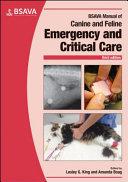BSAVA Manual of Canine and Feline Emergency and Critical Care 3. edition

Akutní péče je jednou z nejdůležitějších oblastí veterinární medicíny. Na základě úspěchu předchozích vydání mezinárodní tým redaktorů a autorů přezkoumal a aktualizoval příručku tak, aby odrážel pokračující růst znalostí a porozumění v této rozhodující oblasti veterinární medicíny psů a koček.
Úvodní kapitoly se zabývají kategorizací akutních pacientů, hodnocení šoku, katetrizace a kanylace pacientů a standardními vyšetřovacími metodami u akutních pacientů a vybavení pracovišť. Druhá kapitola popisuje variabilní přístupy k cévám, jejich způsoby zavádění, komplikace, Třetí kapitola osvětluje šokové stavy od patofyziologie, klasifikace, diagnostiky, terapie, monitoringu a stanovení prognózy. Čtvrtá kapitola je věnována infuzní terapii, na kterou navazuje kapitola o elektrolytové a acidobazické rovnováze. Další kapitoly aktuních stavů jsou rozděleny dle orgánových systémů: kardiovaskulární,respiratorní, vylučovací, neurologický, oční, trávicí, krevní, endokrinologický, kožní. Samostatnými kapitolami jsou zásady využití transfuze krve u pacientů, problematika reprodukce a novorozenců.zvládnutí bolesti u ortopedických pacientů, travičství, kardiopulmonární resuscitace, výživa, problematika bakteriálních infekcí akutních pacientů.
Publikace je velice vkusně ilustrována barevnými fotografiemi, RTG, USG, EKG, CT záznamy, kterým je věnována celá jenda kapitola zabývající se metodami diagnostického zobrazování. Poslední kapitola je věnována řízení týmu na akutním oddělení. Inspirativní jsou algoritmické tabulky určující standardní postupy přizvládání akutních stavů, tabulky nejpoužívanějších a ověřených používaných léčiv, perovky operačních postupů.
Autor: Lesley G. King, MVB, DipACVECC, DipACVIM, graduated from the Faculty of Veterinary Medicine, University College Dublin in 1986. Following a residency in small animal medicine at the University of Pennsylvania, she remained on staff in the Intensive Care Unit as a Professor of Critical Care and Director of the Intensive Care Unit. Lesley was a founding Diplomate of the European College of Veterinary Medicine, and also served as a Diplomate of the American College of Veterinary Internal Medicine and American College of Veterinary Emergency and Critical Care. Amanda Boag, MA, VetMB, DipECVECC, DipACVECC, DipACVIM, FHEA, MRCVS, graduated from Cambridge University. She undertook further clinical training at the Royal Veterinary College (RVC) and the University of Pennsylvania and is Board certified in both internal medicine and emergency and critical (ECC) care. She was a lecturer in ECC at the RVC from 2003-2008, until she took up the post of Clinical Director at Vets Now where she has responsibility for clinical and professional standards across 55 emergency clinics and three 24-hour hospitals. Amanda is the Founding President of the European College of Veterinary ECC, is an elected RCVS Council member and is currently Vice President of the RCVS.
| Nakladatel | British Small Animal Veterinary Association |
|---|---|
| ISBN | 9781905319640 |
| Vydání | III. vydání 2018 |
| Vazba | brožovaná |
| Počet stran | 432 |
Emergency care is one of the most important areas of veterinary medicine. Building on the success of the previous editions, the international editors and authors have reviewed and updated the Manual to reflect the continued growth in knowledge and understanding in this crucial area.
The BSAVA Manual of Canine and Feline Emergency and Critical Care remains a highly practical resource. Retaining the structure of the previous edition, each of the chapters in this third edition has been thoroughly revised to reflect current thinking and practices. The introductory chapters, covering areas such as telephone triage, catheterization and the assessment of shock, sit alongside chapters that cover system specific emergencies, ranging from cardiac arrhythmias to uterine prolapse, and from corneal ulceration to fractures and luxations. The text is fully illustrated throughout.
| Foreword | VII |
| Preface | VIII |
| Andrew J. Brown and Kenneth J. Drobatz 1 Triage of the emergency patient | 1 |
| Sophie Adamantos 2 Vascular access | 8 |
| Emily Thomas and Elise Boller 3 Assessment and treatment of shock | 17 |
| Amanda Boag and Dez Hughes 4 Fluid therapy | 29 |
| Amanda Boag 5 Electrolyte and acid–base balance | 44 |
| José Novo Matos and Nuala Summerfield 6 Cardiovascular emergencies | 55 |
| Lori S. Waddell and Lesley G. King†7 General approach to respiratory distress | 93 |
| Jonathan D. Foster and Karen Humm 8 Renal and urinary tract emergencies | 123 |
| Charles Vite and Evelyn Galban 9 Neurological emergencies | 137 |
| Cristina Seruca and Debbie Mandell 10 Ophthalmological emergencies | 157 |
| Gareth Buckley and Elizabeth Rozanski 11 Approach to gastrointestinal emergencies | 180 |
| David Holt and Gareth Buckley 12 Acute abdominal and gastrointestinal surgical emergencies | 191 |
| Robert Goggs and Susan G. Hackner 13 Haematological emergencies | 210 |
| Gillian Gibson and Mary Beth Callan 14 Transfusion medicine | 236 |
| Erica Reineke and Dan Lewis 15 Reproductive and paediatric emergencies | 249 |
| Barbara J. Skelly 16 Endocrine emergencies | 264 |
| Sorrel Langley-Hobbs and Matthew Pead 17 Acute management of orthopaedic and external soft tissue injuries | 276 |
| Petra Roosje 18 Dermatological emergencies | 294 |
| Jonathan M. Babyak and Justine A. Lee 19 Toxicological emergencies | 304 |
| Edward Cooper and Manuel Boller 20 Cardiopulmonary resuscitation | 318 |
| Giacomo Gianotti and Paulo Steagall 21 Anaesthesia, sedation and analgesia of the critical patient | 334 |
| Kathryn Michel 22 Nutritional support of the critical patient | 354 |
| Iain Keir and Dawn Merton-Boothe 23 Bacterial infections in the critical patient | 365 |
| Andrew Parry and Frances Barr 24 Imaging techniques for the critical patient | 375 |
| Emily Savino and Lila Sierra 25 Team approach to the critically ill patient – the role of the veterinary nurse | 403 |
| Index | 412 |